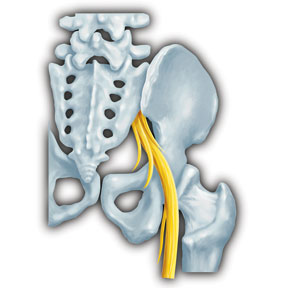Archive for February, 2011
How to Get More Sleep if You Have Sciatica
Posted by relaxtheback in anatomic global mattress, back pain, mattresses, memory foam mattresses, memory foam pillows, neck pain, neck pillow, PureRelax Mattress, sleep on February 16, 2011
Sciatica is painful enough in your waking hours. At bedtime, however, it can be excruciating. Sciatica occurs when the large nerve running down each leg is compressed in your lower spine. Herniated discs, among other maladies, often cause this painful condition. Below are some tips on how to get better rest if you are a sciatica sufferer.
Side sleeping. If you have pain in one leg, try sleeping on the opposite side. This takes the pressure off the nerve, allowing you some relief. You can also place a pillow between your legs. For those with a herniated disc, this helps relieve the pressure the disc puts on the nerve root, which will lessen the pain.
Full body pillow. If you still have pain or discomfort sleeping with a regular pillow between your legs, then try a full-body pillow. Full-body pillows support not only the head, neck, and shoulders, but the hips and torso as well. It also allows for proper spinal alignment and promotes circulation, which is crucial for healing from sciatica.
Avoid sleeping on your stomach. Sleeping on your stomach may seem like a good alternative to side sleeping. At least you’re not aggravating your sciatic nerves by putting pressure on your hips and legs, right? Wrong. Sleeping on your stomach can cause an unnatural curve in your back and neck, and increase the pressure on both. For sciatic sufferers, and everyone else, it’s recommended to avoid sleeping on your stomach, which puts undue pressure on the lower lumbar area and neck.
Pressure relieving mattress. Traditional coil mattresses are known for creating painful pressure points and uneven contours. An overly firm mattress can also cause more discomfort than it relieves, contrary to popular belief. If sciatica keeps you up at night, it’s recommended to sleep on a pressure-relieving mattress. Tempur-Pedic mattresses, in particular, provide excellent body contouring support for sciatica sufferers. Our own line of PureRelax and PureFit mattresses are also effective in treating this condition. Whichever mattress you choose, just make sure that it conforms to your unique contours, rather than the other way around.
Stretch the piriformis muscle before bedtime. The Piriformis is a flat muscle in the pelvis region, near the back of the hip joint. This pyramid-shaped muscle has the sciatic nerve running through it, so massaging it before bedtime can ease sciatica symptoms noticeably. Try a gentle five-minute massage before going to bed for deeper, more restful sleep.
Sciatica can be a pain, but it doesn’t have to keep you from getting a good night’s rest. Although painful, sciatica does respond well to treatment. In fact, roughly 4 out of 5 people with sciatica get better with treatment. Try some of these tips and see if your symptoms improve over time.
For more information, please see www.RelaxTheBack.com.
Tips for Living with Fibromyalgia
Posted by relaxtheback in back pain, back support, mattresses, memory foam pillows, neck pain, sleep on February 1, 2011
Fibromyalgia is a common arthritis-related illness. Fatigue, insomnia, abdominal pain, stiffness, chronic headaches, dry eyes, muscle and joint pain are symptoms of this disease, which affects 12 million people in the US alone. Besides physical pain, there is a mental and emotional component as well. Many fibromyalgia sufferers experience social isolation, loneliness, and depression as a result of their condition.
Below are some ways to cope if you have fibromyalgia.
Get better sleep. Make sure your bedroom is free from distractions. TV, pets, tick-tocking clocks – all of these can throw off your sleep pattern. For reducing fibromyalgia-related insomnia, create a sleep environment that is calm, quiet, and at a slightly cooler temperature. Your bedding is hugely important for getting better sleep as well. A pressure-relieving mattress that reduces pressure points can be particularly beneficial. Tempur-Pedic specializes in these kind of mattresses, which conform to your unique contours in a way that traditional mattresses do not.
Exercise. Because of the pain and fatigue symptoms, it’s not uncommon for people with fibromyalgia to become unfit through lack of exercise. Aerobic exercise, however, is a good way to reduce pain and stay fit. Strenuous exercise, the kind that improves endurance and stamina, helps release endorphins into the blood stream, which provide feelings of well being. Endorphins also have an analgesic effect on tired, achy muscles. With regular exercise, you can curtail fibromyalgia symptoms noticeably.
Learn to say “no.” This may sound like an odd tip for fibromyalgia. However, learning to say no can help prevent you from feeling tired and overburdened. Life presents us with seemingly limitless demands on our time and energy, so it’s important to prioritize. Take time for the things you value, but trying to do everything can leave you feeling overwhelmed and exhausted. Keep in mind, too, that constant tiredness makes it harder to heal. To stay on top of fibromyalgia, learn to say no every now and then. Your body will thank you.
Heat therapy. Heat relaxes muscles and encourages blood flow, both essential for speedy healing. Good circulation also helps remove built up waste left by muscle spasms, a frequent fibromyalgia symptom. Perhaps the most welcome effect of heat therapy is pain reduction. Whether using a heating pad or a moist, warm cloth, heat therapy can relieve chronic aches and pains.
Meet others with fibromyalgia. Oftentimes, people with fibromyalgia feel alienated or depressed because of the severity of their symptoms. It can be difficult to talk about, so we recommend finding a fibromyalgia support group. Talking with others going through the same thing can provide a emotional boost. A support group can also be a great resource for pain-relief tips and encouragement. Many health care providers also endorse support group participation as a way to reduce stress and improve coping skills.
